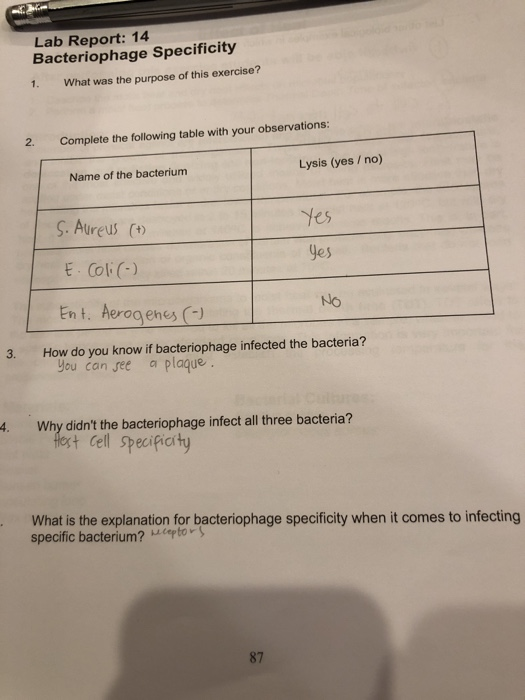QQuestionAnatomy and Physiology
QuestionAnatomy and Physiology
# Lab Report: 14 Bacteriophage Specificity
1. What was the purpose of this exercise?
2. Complete the following table with your observations:
| Name of the bacterium | Lysis (yes / no) |
| --- | --- |
| S. Aureus (1) | Yes |
| E. Coli ( - ) | Yes |
| Ent. Aerogenes ( - ) | No |
1. How do you know if bacteriophage infected the bacteria?
You can see a plaque. 4. Why didn't the bacteriophage infect all three bacteria?
Hest Cell Specificity
What is the explanation for bacteriophage specificity when it comes to infecting specific bacterium? "ceptors
Attachments

6 months agoReport content
Answer
Full Solution Locked
Sign in to view the complete step-by-step solution and unlock all study resources.
Step 1**Step 1:** The purpose of this exercise was to study the specificity of bacteriophages in infecting different bacteria.
**Step 2:** Here is the completed table with your observations: | Name of the bacterium | Lysis (yes / no) | | --- | --- | | S. Aureus (1) | Yes | | E. Coli (−) | Yes | | Ent. Aerogenes (−) | No | **Step 3:** You can determine if a bacteriophage infected the bacteria by observing for lysis (clear zones or plaques) in the bacterial lawn. If lysis occurs, it indicates that the bacteriophage has infected and killed the bacteria. **Step 4:** The bacteriophage did not infect all three bacteria because of bacteriophage specificity, which is the ability of a bacteriophage to infect only specific bacterial strains. This specificity is due to the presence of unique receptors on the surface of the bacterial cells. **Step 5:** Bacteriophage specificity is determined by the interaction between the bacteriophage and the bacterial receptors. The bacteriophage recognizes and binds to specific receptors on the bacterial surface, which allows the bacteriophage to inject its genetic material into the bacterial cell. If the bacterial strain does not have the specific receptors required for bacteriophage binding, the bacteriophage will not be able to infect and kill the bacteria. **
Final Answer
In this exercise, S. Aureus and E. Coli were susceptible to the bacteriophage, while Ent. Aerogenes was not due to the lack of required receptors.
Need Help with Homework?
Stuck on a difficult problem? We've got you covered:
- Post your question or upload an image
- Get instant step-by-step solutions
- Learn from our AI and community of students